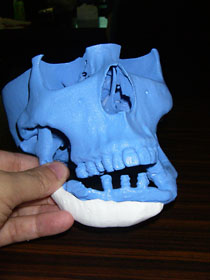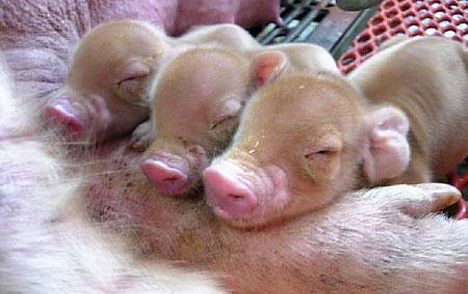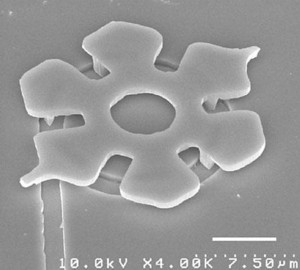 Researchers from the Tissue Engineering Department at the University of Tokyo Hospital and venture company Next 21 are using 3D inkjet printers to produce tailor-made artificial bones for use in facial reconstructive surgery. Following initial trials performed on a Welsh corgi and 10 people over the past year and a half, the researchers are set to begin a more extensive second round of human testing this autumn.
Researchers from the Tissue Engineering Department at the University of Tokyo Hospital and venture company Next 21 are using 3D inkjet printers to produce tailor-made artificial bones for use in facial reconstructive surgery. Following initial trials performed on a Welsh corgi and 10 people over the past year and a half, the researchers are set to begin a more extensive second round of human testing this autumn.
To make an artificial bone with this technology, a 3D computer model of the bone is first created based on the patient's X-ray and CT scan data. The computer model is then sliced into a large number of cross-sections and the data is sent to a special 3D inkjet printer, which works sort of like an ordinary inkjet printer by transferring tiny droplets of liquid onto a surface. However, unlike ordinary printers that print on paper, this one prints onto thin layers of powdered alpha-tricalcium phosphate (alpha-TCP). The "ink" is a water-based polymer adhesive that hardens the alpha-TCP it comes into contact with. By repeatedly laying down the powder and printing successive layers on top of one another, the printer is able to physically reproduce the desired bone to an accuracy of one millimeter.
Strong, lightweight and porous, the printed bones have characteristics similar to natural bone, and because they are tailored to fit exactly where they need to go, they are quick to integrate with the surrounding bone. The printed bone is also designed to be resorbed by the body as the surrounding bone slowly grows into it and replaces it.
In initial human trials conducted between March 2006 and July 2007, the effectiveness and safety of the artificial bones were tested in plastic surgery operations performed on 10 male and female patients between the ages of 18 and 54. In the second round of trials beginning this autumn at 10 medical institutions across Japan, the researchers plan to print up and implant synthetic bones in 70 volunteer patients with face or skull bones that have been damaged or removed due to injury or surgery.
While the printed bones are still not considered strong enough to replace weight-bearing bones, they are ten times stronger than conventional artificial bones made from hydroxylapatite, a naturally occurring mineral that is also the main component of natural bone. The printed bones are also cheaper and easier to make than hydroxylapatite implants, which must be sintered, or heated to a high temperature to get the particles to adhere to each other. In addition to taking longer to produce, sintered implants also take longer for the body to resorb.
The next round of human trials will be conducted at Dokkyo Medical University, Saitama Medical University, Tokyo Dental College, University of Tokyo, Juntendo University, Tsurumi University, Kyoto University, Osaka Medical College, Kobe University and Osaka City General Medical Center.
The researchers hope to make the technology commercially available by 2010.
[Source: Fuji Sankei, The Chemical Daily]


 Researchers from Hokkaido University have created artificial blood vessels using collagen derived from the skin of salmon. The researchers, who replaced the aortas of rats with the artificial blood vessels, claim to be the first to create and successfully test artificial blood vessels made using collagen derived from marine animals.
Researchers from Hokkaido University have created artificial blood vessels using collagen derived from the skin of salmon. The researchers, who replaced the aortas of rats with the artificial blood vessels, claim to be the first to create and successfully test artificial blood vessels made using collagen derived from marine animals.  On January 18, researchers from Japan's Institute of Physical and Chemical Research (
On January 18, researchers from Japan's Institute of Physical and Chemical Research ( On December 12, researchers from Japan's National Agriculture and Food Research Organization (
On December 12, researchers from Japan's National Agriculture and Food Research Organization ( Researchers from Japan's National Institute of Advanced Industrial Science and Technology (
Researchers from Japan's National Institute of Advanced Industrial Science and Technology (